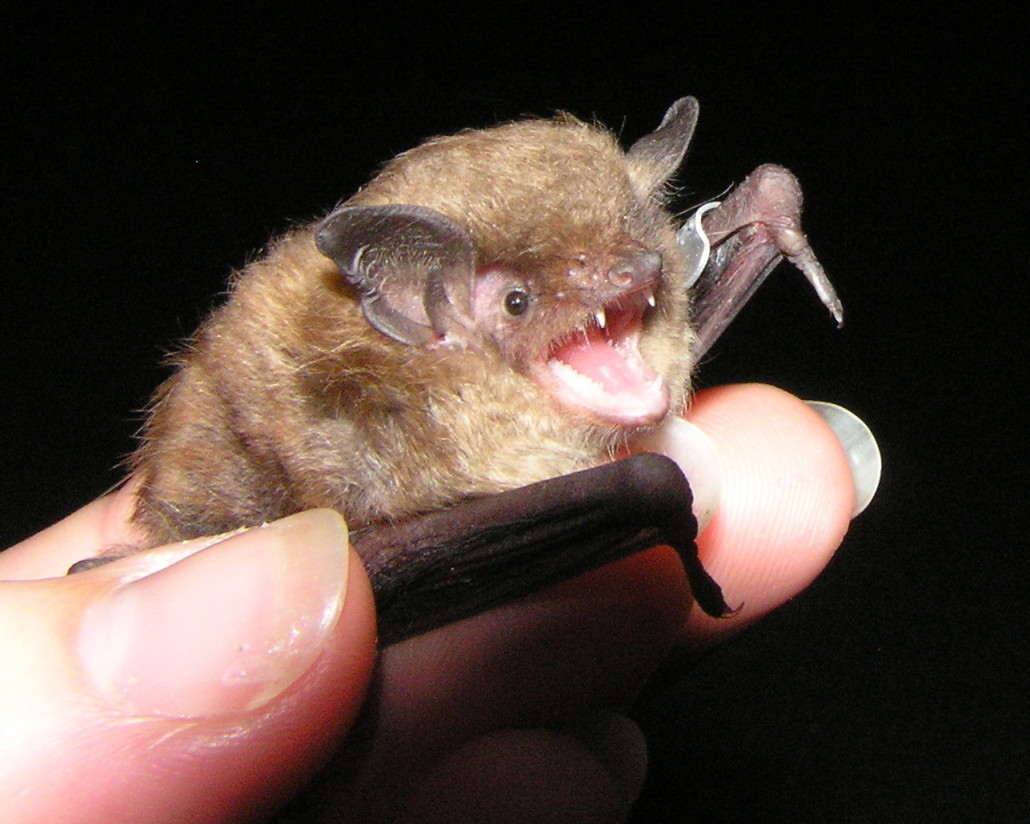
Indiana Bat
Indiana Bat
Indiana bat (Myotis sodalis)
(804) 729-0046 or toll-free at (888) 824-7383
Indiana Bat Removal in VA
Characteristics
The Indiana Bat species is medium sized, with fairly uniform pinkish brown fur that has a fine texture. It has short, inconspicuous toe hairs useful in distinguishing it from M. lucifugus. The total length is 77-91 mm, wing spread 240-267 mm, and weight 1/4-1/3 ounces (5-8 grams). The Indiana bats breed prior to entering hibernation. Females migrate north to establish nursery colonies under loose bark of dead trees in riparian woodland, upland woodlots, or in hedgerows. The one offspring is born late in June or early July. They begin to return to hibernation caves in August, and will migrate up to 300 miles. They enter into hibernation in mid-October. Small numbers are always active, and they awaken every 8-10 days. They require an average winter habitat temperature below 10 degrees C, preferably from 4-8 degrees. They hibernate in small dense clusters of about 300 bats per square foot. Seven winter caves contain 87% of all known Indiana bats. This limited habitat area is why this bat is on the federal endangered species list. They may live to be up to 20 years old.
Distribution
During the winter, the Indiana Bat hibernates in caves in the western part of the state. In the summer, they are found along wooded, or semi-wooded areas along streams, and are associated with cavernous limestone areas. Rivers and streams are important for dispersal, navigation, and feeding.
Foods
The Indiana Bat will emerge at night to feed on moths, mayflies, and other insects in treetops and over streams. They eat flies and butterflies in the spring, moths in the summer and beetles in the fall. Moths and beetles are the largest part of most Indiana bat diets. Optimal foraging habitat is the foliage of riparian and floodplain trees.
For fast, safe and humane Virginia Bat Removal contact us at (804) 729-0046 or toll-free at (888) 824-7383. Call us for more questions on the Indiana bat in Virginia.
Our Service Areas Include:
Afton, Albemarle County, Alexandria, Amelia County, Annandale, Arlington, Ashburn, Ashland, Barboursville, Bellwood, Belmont, Bensley, Bermuda Hundred, Bon Air, Boyd Tavern, Brandermill, Bumpass, Burke, Central VA, Centreville, Chamberlain, Charlottesville, Chesapeake, Chester, Chesterfield County, Colonial Heights, Crozet, Cuckoo, CVille, Dale City, Doswell, Dumbarton, Earlysville, East Highland Park, Enon, Ettrick, Fairfax, Fair Oaks, Ferncliff, Fluvanna County, Fredericksburg, Genito, Glen Allen, Glenora, Goochland County, Gordonsville, Gum Spring, Hadensville, Hampton, Hampton Park, Hanover County, Harrisonburg, Harrogate, Hening, Henrico County, Highland Springs, Hopewell, Innsbrook, Jefferson Davis, Kents Store, Keswick, Lake Anna, Lake Monticello, Lake Ridge, Lakeside, Laurel, Leesburg, Lewiston, Lignum, Locust Grove, Louisa County, Maidens, Manakin, Manakin-Sabot, Manassas, Manchester, McLean, Montrose, Motoaca, Meadowbrook, Mechanicsville, Midlothian, Mineral, Moseley, Newport News, Norfolk, North Courthouse, North Garden, Oilville, Orange County, Palmyra, Pantops, Petersburg, Portsmouth, Powhatan County, Reams, Reston, Richmond, Richmond County, Robious, Rockville, Rockwood, RVA, Salisbury, Sandston, Sandy Hook, Scottsville, Shannon Hill, Short Pump, South Rockwood, Spring Run, Staunton, Stoney Point, Suffolk, Tidewater, Troy, Tuckahoe, Va, Varina, Virginia, Virginia Beach, Waynesboro, Williamsburg, Winchester, Winterpock, Woodlake, Wyndham, and the surrounding areas of Virginia.
We also trap, remove, capture, control, manage and exclude all Virginia Wildlife and Animal Pest Control.
Please Complete Our Simple Contact Form Below:
Go to the full page to view and submit the form.
